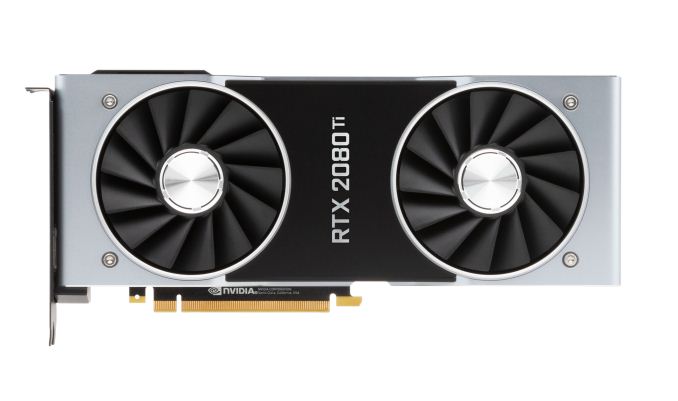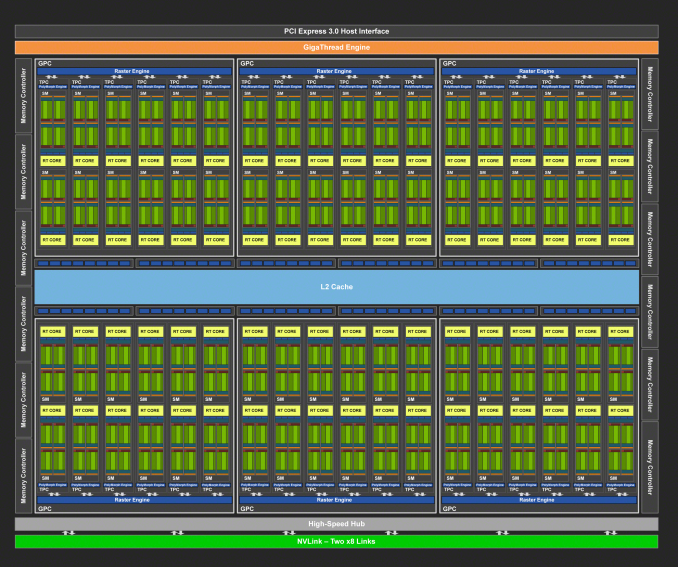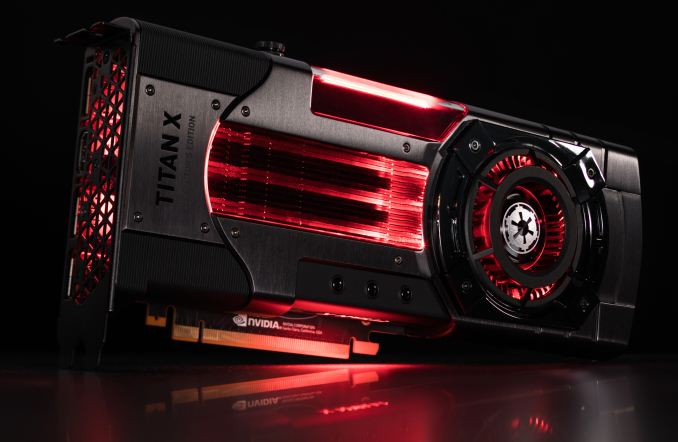The NVIDIA GeForce RTX 2080 Ti & RTX 2080 Founders Edition Review: Foundations For A Ray Traced Future
by Nate Oh on September 19, 2018 5:15 PM EST- Posted in
- GPUs
- Raytrace
- GeForce
- NVIDIA
- DirectX Raytracing
- Turing
- GeForce RTX

While it was roughly 2 years from Maxwell 2 to Pascal, the journey to Turing has felt much longer despite a similar 2 year gap. There’s some truth to the feeling: looking at the past couple years, there’s been basically every other possible development in the GPU space except next-generation gaming video cards, like Intel’s planned return to discrete graphics, NVIDIA’s Volta, and cryptomining-specific cards. Finally, at Gamescom 2018, NVIDIA announced the GeForce RTX 20 series, built on TSMC’s 12nm “FFN” process and powered by the Turing GPU architecture. Launching today with full general availability is just the GeForce RTX 2080, as the GeForce RTX 2080 Ti was delayed a week to the 27th, while the GeForce RTX 2070 is due in October. So up for review today is the GeForce RTX 2080 Ti and GeForce RTX 2080.
But a standard new generation of gaming GPUs this is not. The “GeForce RTX” brand, ousting the long-lived “GeForce GTX” moniker in favor of their announced “RTX technology” for real time ray tracing, aptly underlines NVIDIA’s new vision for the video card future. Like we saw last Friday, Turing and the GeForce RTX 20 series are designed around a set of specialized low-level hardware features and an intertwined ecosystem of supporting software currently in development. The central goal is a long-held dream of computer graphics researchers and engineers alike – real time ray tracing – and NVIDIA is aiming to bring that to gamers with their new cards, and willing to break some traditions on the way.
| NVIDIA GeForce Specification Comparison | ||||||
| RTX 2080 Ti | RTX 2080 | RTX 2070 | GTX 1080 | |||
| CUDA Cores | 4352 | 2944 | 2304 | 2560 | ||
| Core Clock | 1350MHz | 1515MHz | 1410MHz | 1607MHz | ||
| Boost Clock | 1545MHz FE: 1635MHz |
1710MHz FE: 1800MHz |
1620MHz FE: 1710MHz |
1733MHz | ||
| Memory Clock | 14Gbps GDDR6 | 14Gbps GDDR6 | 14Gbps GDDR6 | 10Gbps GDDR5X | ||
| Memory Bus Width | 352-bit | 256-bit | 256-bit | 256-bit | ||
| VRAM | 11GB | 8GB | 8GB | 8GB | ||
| Single Precision Perf. | 13.4 TFLOPs | 10.1 TFLOPs | 7.5 TFLOPs | 8.9 TFLOPs | ||
| Tensor Perf. (INT4) | 430TOPs | 322TOPs | 238TOPs | N/A | ||
| Ray Perf. | 10 GRays/s | 8 GRays/s | 6 GRays/s | N/A | ||
| "RTX-OPS" | 78T | 60T | 45T | N/A | ||
| TDP | 250W FE: 260W |
215W FE: 225W |
175W FE: 185W |
180W | ||
| GPU | TU102 | TU104 | TU106 | GP104 | ||
| Transistor Count | 18.6B | 13.6B | 10.8B | 7.2B | ||
| Architecture | Turing | Turing | Turing | Pascal | ||
| Manufacturing Process | TSMC 12nm "FFN" | TSMC 12nm "FFN" | TSMC 12nm "FFN" | TSMC 16nm | ||
| Launch Date | 09/27/2018 | 09/20/2018 | 10/2018 | 05/27/2016 | ||
| Launch Price | MSRP: $999 Founders $1199 |
MSRP: $699 Founders $799 |
MSRP: $499 Founders $599 |
MSRP: $599 Founders $699 |
||
As we discussed at the announcement, one of the major breaks is that NVIDIA is introducing GeForce RTX as the full upper tier stack with x80 Ti/x80/x70 stack, where it has previously tended towards the x80/x70 products first, and the x80 Ti as a mid-cycle refresh or competitive response. More intriguingly, each GeForce card has their own distinct GPU (TU102, TU104, and TU106), with direct Quadro and now Tesla variants of TU102 and TU104. While we covered the Turing architecture in the preceding article, the takeaway is that each chip is proportionally cut-down, including the specialized RT Cores and Tensor Cores; with clockspeeds roughly the same as Pascal, architectural changes and efficiency enhancements will be largely responsible for performance gains, along with the greater bandwidth of 14Gbps GDDR6.
And as far as we know, Turing technically did not trickle down from a bigger compute chip a la GP100, though at the architectural level it is strikingly similar to Volta/GV100. Die size brings more color to the story, because with TU106 at 454mm2, the smallest of the bunch is frankly humungous for a FinFET die nominally dedicated for a x70 GeForce product, and comparable in size to the 471mm2 GP102 inside the GTX 1080 Ti and Pascal Titans. Even excluding the cost and size of enabled RT Cores and Tensor Cores, a slab of FinFET silicon that large is unlikely to be packaged and priced like the popular $330 GTX 970 and still provide the margins NVIDIA is pursuing.
These observations are not so much to be pedantic, but more so to sketch out GeForce Turing’s positioning in relation to Pascal. Having separate GPUs for each model is the most expensive approach in terms of research and development, testing, validation, extra needed fab tooling/capacity – the list goes on. And it raises interesting questions on the matter of binning, yields, and salvage parts. Though NVIDIA certainly has the spare funds to go this route, there’s surely a better explanation than Turing being primarily designed for a premium-priced consumer product that cannot command the margins of professional parts. These all point to the known Turing GPUs as oriented for lower-volume, and NVIDIA’s financial quarterly reports indicate that GeForce product volume is a significant factor, not just ASP.
And on that note, the ‘reference’ Founders Edition models are no longer reference; the GeForce RTX 2080 Ti, 2080, and 2070 Founders Editions feature 90MHz factory overclocks and 10W higher TDP, and NVIDIA does not plan to productize a reference card themselves. But arguably the biggest change is the move from blower-style coolers with a radial fan to an open air cooler with dual axial fans. The switch in design improves cooling capacity and lowers noise, but with the drawback that the card can no longer guarantee that it can cool itself. Because the open air design re-circulates the hot air back into the chassis, it is ultimately up to the chassis to properly exhaust the heat. In contrast, a blower pushes all the hot air through the back of the card and directly out of the case, regardless of the chassis airflow or case fans.
All-in-all, NVIDIA is keeping the Founders Edition premium, which is now $200 over the baseline ‘reference.’ Though AIB partner cards are also launching today, in practice the Founders Edition pricing is effectively the retail price until the launch rush has subsided.
The GeForce RTX 20 Series Competition: The GeForce GTX 10 Series
In the end, the preceding GeForce GTX 10 series ended up occupying an odd spot in the competitive landscape. After its arrival in mid-2016, only the lower end of the stack had direct competition, due to AMD’s solely mainstream/entry Polaris-based Radeon RX 400 series. AMD’s RX 500 series refresh in April 2017 didn’t fundamentally change that, and it was only until August 2017 that the higher-end Pascal parts had direct competition with their generational equal in RX Vega. But by that time, the GTX 1080 Ti (not to mention the Pascal Titans) was unchallenged. And all the while, an Ethereum-led resurgence of mining cryptocurrency on video cards was wreaking havoc on GPU pricing and inventory, first on Polaris products, then general mainstream parts, and finally affecting any and all GPUs.
Not that NVIDIA sat on their laurels with Vega, releasing the GTX 1070 Ti anyhow. But what was constant was how the pricing models evolved with the Founders Editions schema, the $1200 Titan X (Pascal), and then $700 GTX 1080 Ti and $1200 Titan Xp. Even the $3000 Titan V maintained gaming cred despite diverging greatly from previous Titan cards as firmly on the professional side of prosumer, basically allowing the product to capture both prosumers and price-no-object enthusiasts. Ultimately, these instances coincided with the rampant cryptomining price inflation and was mostly subsumed by it.
So the higher end of gaming video cards has been Pascal competing with itself and moving up the price brackets. For Turing, the GTX 1080 Ti has become the closest competitor. RX Vega performance hasn’t fundamentally changed, and the fallout appears to have snuffed out any Vega 10 parts, as well as Vega 14nm+ (i.e. 12nm) refreshes. As a competitive response, AMD doesn’t have many cards up their sleeves except the ones already played – game bundles (such as the current “Raise the Game” promotion), FreeSync/FreeSync 2, other hardware (CPU, APU, motherboard) bundles. Other than that, there’s a DXR driver in the works and a machine learning 7nm Vega on the horizon, but not much else is known, such as mobile discrete Vega. For AMD graphics cards on shelves right now, RX Vega is still hampered by high prices and low inventory/selection, remnants of cryptomining.
For the GeForce RTX 2080 Ti and 2080, NVIDIA would like to sell you the RTX cards as your next upgrade regardless of what card you may have now, essentially because no other card can do what Turing’s features enable: real time raytracing effects ((and applied deep learning) in games. And because real time ray tracing offers graphical realism beyond what rasterization can muster, it’s not comparable to an older but still performant card. Unfortunately, none of those games have support for Turing’s features today, and may not for some time. Of course, NVIDIA maintains that the cards will provide expected top-tier performance in traditional gaming. Either way, while Founders Editions are fixed at their premium MSRP, custom cards are unsurprisingly listed at those same Founders Edition price points or higher.
| Fall 2018 GPU Pricing Comparison | |||||
| AMD | Price | NVIDIA | |||
| $1199 | GeForce RTX 2080 Ti | ||||
| $799 | GeForce RTX 2080 | ||||
| $709 | GeForce GTX 1080 Ti | ||||
| Radeon RX Vega 64 | $569 | ||||
| Radeon RX Vega 56 | $489 | GeForce GTX 1080 | |||
| $449 | GeForce GTX 1070 Ti | ||||
| $399 | GeForce GTX 1070 | ||||
| Radeon RX 580 (8GB) | $269/$279 | GeForce GTX 1060 6GB (1280 cores) |
|||













337 Comments
View All Comments
mapesdhs - Thursday, September 27, 2018 - link
Does the site earn anything from your reading their articles? Just curious.sing_electric - Thursday, September 20, 2018 - link
I really wonder how well raytracing will be implemented in the next 1-2 years. My bet is that for many of the titles Nvidia's announced, the effects will be limited and sort of gimicky, and the real benefits will come with titles that are starting development now (or, more likely, in a few months, when devs can look at how the 1st attempts at using RT faired).If my hunch is right, then that means that the RT features are likely to be of little practical use in this generation, since the real benefits won't come until some point after Nvidia's next-gen (7nm? 5?) chips come out with much-improved performance.
MadManMark - Thursday, September 20, 2018 - link
It sounds like the 2080 TI at maybe 1440 might be viable for RT. But yeah, for the most part this is about the future, and starting to get some games out there so for future releses there is not the "chicken & egg" problem they have now (no games to use it for, but reason there are no games is there are no cards to use it).Nvidia clearly sacrificing short-term profitability to establish this base; notice how the 2080 is both priced & performs about the same as the 1080 Ti. With the larger die size despite 12nmFF, driver development costs, etc, there is little doubt in my mind that Nvidia will be making a bigger margin on the 1080 Ti than the 2080. But they want to make it cheap enough so that, even if there is little to gain RIGHT NOW from buying 2080 instead fo 1080 Ti, there is also little lost either.
milkod2001 - Thursday, September 20, 2018 - link
It will have to be AMD who also jumps on raytracing thing first then maybe game developers will take it seriously.MadManMark - Thursday, September 20, 2018 - link
"Bartender, I'll have what milkod2001's having!" ;)El Sama - Thursday, September 20, 2018 - link
RTX 2080 not worth buying right now, 1080ti is cheaper (lol), cooler and performs equal. RTX 2080ti is a 1200+ Card that is around 60% price increase from 1080ti for a 25-28% performance increase? How is that a good purchase? Neither of them are worth buying right now.Toadster - Thursday, September 20, 2018 - link
decisions - 24 monthly payments for an iPhone XS Max? or GTX 2080Ti :)milkod2001 - Thursday, September 20, 2018 - link
Get iPhone if you want to be cool guy, you cannot put RTX 2080ti into your pocket :)Arbie - Thursday, September 20, 2018 - link
THANK YOU for the Ashes of the Singularity benchmark results. The deltas may not translate to other games but show me exactly what to expect from an upgrade.darckhart - Thursday, September 20, 2018 - link
But NVIDIA's key features - such as real time ray tracing and DLSS - aren't being utilized by any games right at launch. In fact, it's not very clear at all when those games might arrive, because NVIDIA ultimately is reliant on developers here.In the Star Wars Reflections demo, we measured the RTX 2080 Ti Founders Edition managing around a 14.7fps average at 4K and 31.4fps average at 1440p when rendering the real time ray traced scene. With DLSS enabled, it jumps to 33.8 and 57.2fps
Direct quotes from article. Price premium for NV tech that (1) will not be in games at launch and may have months of buggy implementation from early adoption and may not have widespread adoption, (2) needs extreme help from DLSS to have usable framerates. Should've been named DTX not RTX.